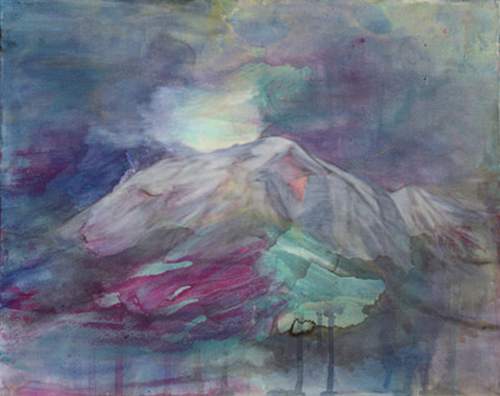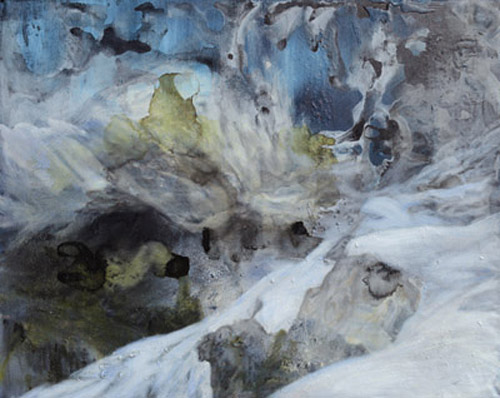Jan Holthoff’s Landscape Events
October 20 – February 25, 2013
 |
| Fractured Mountain pigment, acrylic on canvas 39.5 x 31.5 in. 2012 |
 |
| catalog (pdf download (656 KB) |
more from Jan Holthoff
And then with equal energy he moves into the territory of the canvas itself. And by that I mean the treacherous theoretical landscape of painting. Jan describes his approach as consisting in these two fundamental experiences of landscape and painted surface — the event in the world and the event on canvas. But what is important to grasp here is that for Holthoff this duality is not arbitrary. It is not merely a matter of experiencing here the landscape and there the act of painting, and then wrapping the two experiences up in some kind of a painterly resolution. Rather, the strength of these paintings is that they suggest irreconcilable tensions between surface and landscape, almost an indifference of the one to the other, or a conflict. They resist the compulsion to reconcile surface with landscape, and it is in that resistance that the painting paradoxically subsists.
There has been some vivid writing out of Germany about Holthoff’s art, about his highly original and unsettling technique, his famous “fractured and recomposed” and “fissured” surfaces (Michael Voets). There is a huge spectrum of types of application and strata in Holthoff’s canvases. And the passages of paint seem to move in their own world, against that of the landscape. This separateness of the surface contrives to distance the landscape, makes it more jarring, as landscapes are actually experienced in the world.
 |
| Riding the Snake pigment, acrylic on canvas, 70.8 x 118.1 in. Galerie Wittenbrink installation, Munich 2012 |
 |
| Rising Sun pigment, acrylic on canvas 39.5 x 31.5 in. 2012 |
Vast mountain ranges and deserts are indeed “indifferent” to art and, for that matter, to all of human existence. This is why aesthetic philosophy (namely Kant) places the majesty of huge or terrifying natural events such as mountains or tsunamis in their own category, that of the sublime, which is different from beauty. Jan’s paintings seize this point and these extremities. He does not render landscapes so much as give witness to them through an ordeal in paint. It is “process painting” taken to a whole new level with regard to the experience of landscape.
“The gesture in paint is a trace of my subjectivity,” says Jan. “And this comes together with the subjectivity of my experience of landscape. Experience of landscape, experience of painting. Experience is the key in both cases. But it is really about subjectivity. I don’t get images from the Internet, I don’t work with film stills. I get all my images from traveling. It’s about the value of subjectivity.”
Jan cites Tachism and the “Art Informel” of post-war Europe as an influence. These movements have been called a European answer to American abstraction and color field painting. It was not so much “informal art” as it was an art characterized by the absence of form and premeditated structure as primary concerns of painting. It is a more casual, loose, intuitive application of paint that draws even further away from formalism than the New York School had done. It is not a new idea, but Holthoff takes it up with renewed focus. The looseness, the unraveling of paint on canvas, this loose approach, now engulfs the whole of an experience of landscape. And that in turn unearths matters of painting latent in Friedrich and the German Romantic painters.
These are important paintings. Their appearance in Bushwick is timely. In any case, I think they have something interesting to contribute to a robust movement in abstract and non-objective painting that has been underway here for some years now.
— Ethan Pettit, October 2012
“The gesture in paint is a trace of my subjectivity,” says Jan. “And this comes together with the subjectivity of my experience of landscape. Experience of landscape, experience of painting. Experience is the key in both cases. But it is really about subjectivity. I don’t get images from the Internet, I don’t work with film stills. I get all my images from traveling. It’s about the value of subjectivity.”
 |
| A Kind of Death pigment, acrylic on canvas 39.5 x 31.5 in. 2012 |
 |
| Flickering pigment, acrylic on canvas, 39.5 x 31.5 in. 2012 |
There is a great sense of release and of a perpetual unwinding in these canvases, a slackening of the sinews that compel a correspondence of surface and landscape. In Flickering (2012) the paint heaves and coagulates at cross-purposes with the gully of alpine snow and rock that is its image. All of the conventional relationships between surface and landscape, and also between object and subject, are torn asunder, and the act of painting now revolves around some new organizing principle.
It is as if the paint were a continuous extension of the landscape … by dint of being at odds with it. As if the canvas were merely the residue or the document of a chemical reaction involving landscape and subject. And as in chemistry, the agent and substrate are both part of a single and unitary event, and yet also riven by the differences in their properties.
Jan cites Tachism and the “Art Informel” of post-war Europe as an influence. These movements have been called a European answer to American abstraction and color field painting. It was not so much “informal art” as it was an art characterized by the absence of form and premeditated structure as primary concerns of painting. It is a more casual, loose, intuitive application of paint that draws even further away from formalism than the New York School had done. It is not a new idea, but Holthoff takes it up with renewed focus. The looseness, the unraveling of paint on canvas, this loose approach, now engulfs the whole of an experience of landscape. And that in turn unearths matters of painting latent in Friedrich and the German Romantic painters.
These are important paintings. Their appearance in Bushwick is timely. In any case, I think they have something interesting to contribute to a robust movement in abstract and non-objective painting that has been underway here for some years now.
— Ethan Pettit, October 2012

